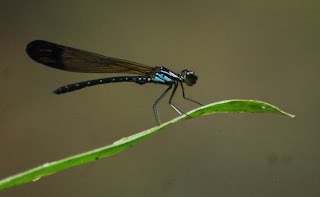A one-day visit cannot do more than scratch the surface of this huge place, but even so it gave me enough for three posts. The next two will be devoted to a sampling of Kaeng Krachan's fabulous butterfly fauna (around 300 species!), so lepidoptera enthusiasts (I know you're out there) will have to wait. This entry covers everything else (plus, as a sop to the lepidopterists, one moth).
The big animals, of course, stayed out of sight, but we had a sad taste of them at the park interpretative centre: piles of Asian Elephant bones (Elephas maximus)…
…and sets of antlers of Thailand's deer. In the middle is the saddest exhibit: the antlers of Schomburgk's Deer (Rucervus schomburgki), a species now extinct.
Once we got out into the park proper, we did see one sign that elephants had, indeed, passed this way: a pile of dung by the side of the road, here being inspected by Ian Redmond (who is, among other things, a noted elephant conservationist).
Edwin had advertised our outing as a birding trip (a sop to me, I suspect), and here we are dutifully peering through our binoculars. However, It seemed that the best reason for our vehicles to move on from a given spot, as the day proceeded, was that there was "nothing to see but birds".
Of course, we did see a few birds all the same. Here is an Emerald Dove (Chalcophaps indica) that crossed the road in front of us late in the afternoon…
And here is a Red-wattled Lapwing (Vanellus indicus), a species that only reaches the north of the Malay Peninsula but is common in western Thailand.
In a palm thicket along the road through the park, I found an Ochraceous Bulbul (Alophoixus ochraceus) attending its nest.
By and large, though, peering into the treetops produced fairly few results (at least as far as birds were concerned).
It did turn up some arboreal plants, though, including this staghorn fern (Platycerium sp.; possibly P. holtumii?).
At ground level, I found this exotic-looking shrub - a lavender flower (Pseuderanthemum sp., possibly P. crenulatum; Acanthaceae).
I also found this mushroom (of sorts; hey, I'm even less of a mycologist than I am a botanist).
Large water striders (Gerridae) skated over the surface of quieter stretches. I think this is the same species I have seen commonly in Malaysia, or at least something very much like it.
Among the damselflies was this brilliant little Heliocypha biforata (Chlorocyphidae). I have seen the same species in West Malaysia where, as here, it sits (usually) on dimly-lit boulders in rippling forest streams.
Euphaea ochracea is, I think, one of the prettiest of all damselflies. In a recent post I showed an immature, with bright yellow stripes on its thorax. This one, though, appears to be an older male, with the stripes already beginning to darken and fade.

Vestalis damselflies usually sit on leaves above a stream or forest trail (well, that's where I usually find them). Identifying them to species usually requires examination in hand, so these must remain "Vestalis sp." only.

...and both of the common species of Trithemis, the glowing pink Trithemis aurora…
... and the dark blue, orange-spotted Trithemis festiva, a species that ranges across the whole of Southern Asia to southern Turkey.
... and the dark blue, orange-spotted Trithemis festiva, a species that ranges across the whole of Southern Asia to southern Turkey.
These were all dragonflies that I see commonly in Malaysia. This one wasn't: a large and spectacular member of the family Gomphidae perched over a dark forest stream. As far as I can tell it is Gomphidia kruegeri, an Indochinese species that apparently does not reach Malaysia.
Thailand is knee-deep in cicadas, and I have no idea which one this little pinkish-brown specimen, perched on a colleague's pant leg, actually is.
Here is the moth I promised you - not one if the more spectacular species, I confess, but a very effective dead-leaf mimic.
Notice the broad, flattened plates on this moth's legs. I presume they serve to break up or confuse their outline; after all, rolled-up dead leaves aren't supposed to have legs.
Seemingly waiting for us on the road, as we pressed on through the park, was this Green Crested Lizard (Bronchocela cristatella).
This Spotted Forest Skink (Sphenomorphus maculatus), a member of a widespread southeast Asian species, preferred to watch us from the safety of the leaf litter....
...while this young Water Monitor (Varanus salvator) was, apparently, large enough not to care where it was as we passed by. Its bright yellow patterning will darken with age.
Our "birdwatching" stops (that is, our stops to look up into the trees for anything but birds) centred, mostly, around families of Dusky Langurs (Trachypithecus obscurus). I can hardly blame Edwin for that; a fellow birder once commented to me that "the best bird of the day is a mammal". Besides, Dusky Langurs are particularly charming animals.
This mother was carrying a small, bright orange baby clinging to her belly, gazing down at its large, hairless cousins.
Baby langurs have to keep a reflexive grip on their mother's belly hair - a reflex that, apparently, even survives in human babies, though we tend to leap from tree to tree far less often.
Our drive took us, finally, to a viewpoint overlooking Mount Panoenthung, one of the highest points in the park.
At the lookout we were high enough up to find a bird that, though common and easy to see in second-growth an edge situations, isn't supposed to be found below about 900 metres: a Flavescent Bulbul (Pycnonotus flavescens).
We spent some time here before heading home, both admiring the view…






+IMG_1248.jpg)


+DSC_7316.jpg)
+DSC_7113.jpg)
+DSC_7115.jpg)
+DSC_7117.jpg)





+DSC_7089.jpg)











+DSC_7122.jpg)
+DSC_7030.jpg)
+DSC_7034.jpg)
+DSC_7245.jpg)
+DSC_7250.jpg)
+DSC_7290.jpg)
+DSC_7284.jpg)
+DSC_7288.jpg)
+DSC_7296.jpg)
+DSC_7307.jpg)



+DSC_7269.jpg)
+DSC_7270.jpg)
+DSC_7277.jpg)








+DSC_6897.jpg)
+DSC_6896.jpg)
+DSC_6899.jpg)
+DSC_6901.jpg)








+DSC_6940.jpg)
+DSC_6950.jpg)